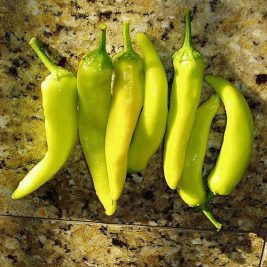5 items, ₨2,395
-
₨120
ladies’ fingers or Ochro, is a flowering plant in the mallow family. It is valued for its edible green seed pods. The geographical origin of okra is disputed, with supporters of West African, Ethiopian, and South Asian origins
-
₨120
The habanero is a hot variety of chili pepper. Unripe habaneros are green, and they color as they mature. The most common color variants are orange and red, but the fruit may also be white, brown, yellow, green, or purple. Typically, a ripe habanero is 2–6 cm long
-
₨120
Capsicum annuum is a species of the plant genus Capsicum native to southern North America and northern South America. This species is the most common and extensively cultivated of the five domesticated capsicums.
-
₨120
The cayenne pepper is a type of Capsicum annuum. It is usually a moderately hot chili pepper used to flavor dishes
-
₨120
This pepper is usually harvested before maturity when still yellow. It measures between 4″-6″ inches in length (10-15cm) which tapers to a rounded point. Upon maturity, the pepper becomes orange then red in color.
-
-
₨120
Ipomoea tricolor, the Mexican morning glory or just morning glory, is a species of flowering plant in the family Convolvulaceae, native to the New World tropics, and widely cultivated and naturalized elsewhere. It is an herbaceous annual or perennial twining liana growing to 2–4 m tall
Ipomoea coccinea is a flowering plant in the family Convolvulaceae known by several common names including red morning glory,Mexican morning glory. It was first described by Linnaeus in 1753.
-
₨120
Ipomoea tricolor, the Mexican morning glory or just morning glory, is a species of flowering plant in the family Convolvulaceae, native to the New World tropics, and widely cultivated and naturalised elsewhere. It is an herbaceous annual or perennial twining liana growing to 2–4 m tall
Ipomoea coccinea is a flowering plant in the family Convolvulaceae known by several common names including red morning glory, red star and Mexican morning glory. It was first described by Linnaeus in 1753.
Red morning glories are fast growing, twisting climbing flowering vines that attract butterflies. The leaves are circular type , and commonly are three-lobed. They grow up to be about 2-4 inches long and about half as wide. The vines can reach 10 or more feet in length. The flowers are dull red with an orange throat. Red morning glory flowers are borne in clusters of a half dozen.
-
₨120
Morning glory is the common name for over 1,000 species of flowering plants in the family Convalescence, whose current taxonomy and systematic are in flux.
-
₨120
A perennial herbaceous plant, with elliptic, obtuse leaves. It grows as a vine or creeper, doing well in moist, neutral soil. The most striking feature about this plant is the color of its flowers, a vivid deep blue; solitary, with light yellow markings. They are about 4 cm (1.6 in) long by 3 cm (1.2 in) wide. Some varieties yield white flowers.
-
₨120
Thunbergia alata, commonly called black-eyed Susan vine, is a herbaceous perennial climbing plant species in the Acanthaceae family. It is native to Eastern Africa, and has been naturalized in other parts of the world
-
₨119
Height: 1 ft- 2 ft
Ribbon grass (Phalaris arundinacea) is a relatively small grass, growing only about a foot high. It has a dense mat of foliage with strappy leaves that begin with pink or white tinged variegation. As the leaves mature, they become striped with green and white, which has earned them the name gardener’s garters. They are also called reed canary grass. The plants are native to Europe and North America and are hardy in USDA gardening zones 4 to 9. Occasionally the plant will form a small flower in June or July which becomes a grain-like fruit. This is uncommon and the plant is limited to its foliage finery as its focal interest.
Read more at Gardening Know How: Ribbon Grass Information: Tips For Growing Ornamental Ribbon Grass
-
Contact UsYou may connect with Team Greene at 0330-3450001
-
After SalesEven after Sales, Greene is there for you !!!
-
Return PolicyIf Product has a fault, Greene Returns *(T&C)
















